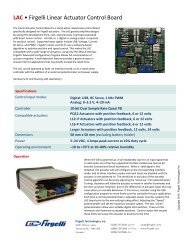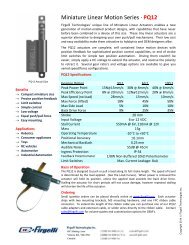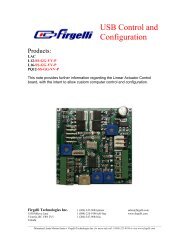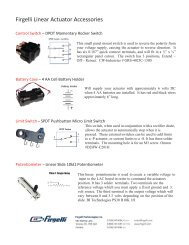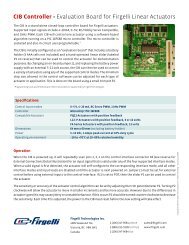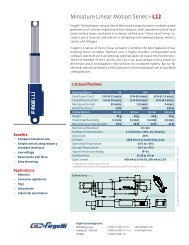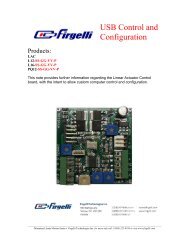Computer Control with Labview
Computer Control with Labview
Computer Control with Labview
You also want an ePaper? Increase the reach of your titles
YUMPU automatically turns print PDFs into web optimized ePapers that Google loves.
For V:<br />
For I:<br />
RC:<br />
• 0 Volts will fully retract the actuator.<br />
• 5 Volts will fully extend the actuator.<br />
• An analog output can be used to generate a voltage between 0-5V.<br />
• A digital output can also be used when PWM is applied to vary the average<br />
voltage between 0-5V.<br />
• 4mA will full retract the actuator.<br />
• 20mA will fully extend the actuator.<br />
• The NI6008 can not source sufficient current for this mode. The V mode is<br />
recommended instead, however other models may support this.<br />
• A continuous square wave signal <strong>with</strong> time high pulses between 1 and 2ms.<br />
• 1ms pulses will fully retract the actuator.<br />
• 2ms pulses will fully retract the actuator.<br />
• A digital output is used to generate this signal.<br />
In <strong>Labview</strong> the NI-6008 can be controlled using the built in blocks for the 6008.<br />
<strong>Control</strong>ling Actuators that do not have an integrated controller:<br />
Firgelli’s –P <strong>with</strong> linear feedback can be controlled as described above <strong>with</strong> the addition<br />
of a Firgelli CIB.<br />
The –B and -S basic actuators <strong>with</strong> and <strong>with</strong>out limit switches can be controlled <strong>with</strong> the<br />
addition of power relays. When choosing a relay, keep in mind the maximum current<br />
your controller can output (The NI-6008 uses pull ups so it will not work for this),<br />
actuator current requirements (L12 0.5A – 1A are good choices), and voltage (30V is a<br />
standard value).<br />
A DPDT type relay works well if you just want to fully extend and retract the actuator,<br />
relying on limit switches to stop the motor. Two SPST relays can be used to allow more<br />
control. Rough position control can then be achieved using timed movements.



